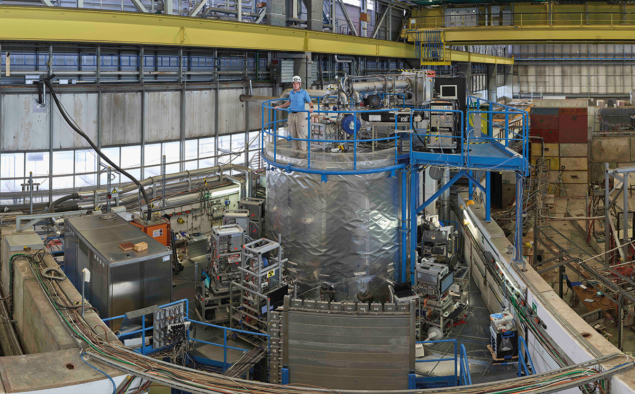CERN’s Cosmics Leaving Outdoor Droplets (CLOUD) experiment has merged the best of particle physics and atmospheric science into a novel experimental approach. Spokesperson Jasper Kirkby argues that this interdisciplinarity could benefit climate modelling, too.

What, in a nutshell, is CLOUD?
It’s basically a cloud chamber, but not a conventional one as used in particle physics. We realistically simulate selected atmospheric environments in an ultraclean chamber and study the formation of aerosol particles from trace vapours, and how they grow to become the seeds for cloud droplets. We can precisely control all the conditions found throughout the atmosphere such as gas concentrations, temperature, ultraviolet illumination and “cosmic ray” intensity with a beam from CERN’s Proton Synchrotron (PS). The aerosol processes we study in CLOUD are poorly known yet climatically important because they create the seeds for more than 50% of global cloud droplets.
We have 22 institutes and the crème de la crème of European and US atmospheric and aerosol scientists. It’s a fabulous mixture of physicists and chemists, and the skills we’ve learned from particle physics in terms of cooperating and pooling resources have been incredibly important for the success of CLOUD. It’s the CERN model, the CERN culture that we’ve conveyed to another discipline. We implemented the best of CERN’s know-how in ultra-clean materials and built the cleanest atmospheric chamber in the world.
How did CLOUD get off the ground?
The idea came to me in 1997 during a lecture at CERN given by Nigel Calder, a former editor of New Scientist magazine, who pointed out a new result from satellite data about possible links between cosmic rays and cloud formation. That Christmas, while we visited relatives in Paris, I read a lot of related papers and came up with the idea to test the cosmic ray–cloud link at CERN with an experiment I named CLOUD. I did not want to ride into another field telling those guys how to do their stuff, so I wrote a note of my ideas and started to make contact with the atmospheric community in Europe and build support from lab directors in particle physics. I managed to assemble a dream team to propose the experiment to CERN. The hard part was convincing CERN that they should do this crazy experiment. We proposed it in 2000 and it was finally approved in 2006, which I think is a record for CERN to approve an experiment. There were some people in the climate community who were against the idea that cosmic rays could influence clouds. But we persevered and, once approved, things went very fast. We started taking data in 2009 and have been in discovery mode ever since.
Do you consider yourself a particle physicist or an atmospheric scientist?
An experimental physicist! My training and my love is particle physics, but judging by the papers I write and review, I am now an atmospheric scientist. It was not difficult to make this transition. It was a case of going back to my undergraduate physics and high-school chemistry and learning on the job. It’s also very rewarding. We do experiments, like we all do at CERN, on a 24/7 basis, but with CLOUD I can calculate things in my notebook and see the science that we are doing, so we know immediately what the new stuff is and we can adapt our experiments continuously during our run.
On the other hand, in particle physics the detectors are running all the time but we really don’t know what is in the data without years of very careful analysis afterwards, so there is this decoupling of the result from the actual measurement. Also, in CLOUD we don’t need a separate discipline to tell us about the underlying theory or beauty of what we are doing. In CLOUD you’re the theorist and the experimentalist at the same time – like it was in the early days of particle physics.
How would you compare the Standard Model to state-of-the-art climate models?
It’s night and day. The Standard Model (SM) is such a well formed theory and remarkably high-quality quantitatively that we can see incredibly subtle signals in detectors against a background of something that is extremely well understood. Climate models, on the other hand, are trying to simulate a very complex system about what’s happening on Earth’s surface, involving energy exchanges between the atmosphere, the oceans, the biosphere, the cryosphere … and the influence of human beings. The models involve many parameters that are poorly understood, so modellers have to make plausible yet uncertain choices. As a result, there is much more flexibility in climate models, whereas there is almost none in the SM. Unfortunately, this flexibility means that the predictive power of such models is much weaker than it is in particle physics.

There are skills such as the handling of data, statistics and software optimisation where particle physics is probably the leading science in the world, so I would love to see CERN sponsor a workshop where the two communities could exchange ideas and perhaps even begin to collaborate. This is what CLOUD has done. It’s politically correct to talk about the power of interdisciplinary research, but it’s very difficult in practical terms – especially when it comes to funding because experiments often fall into the cracks between funding agencies.
How has CLOUD’s focus evolved during a decade of running?
CLOUD was designed to explore whether variations of cosmic rays in the atmosphere affect clouds and climate, and that’s still a major goal. What I didn’t realise at the beginning is how important aerosol–particle formation is for climate and health, and just how much is not yet understood. The largest uncertainty facing predictions of global warming is not due to a lack of understanding about greenhouse gases, but about how much aerosols and clouds have increased since pre-industrial times from human activities. Aerosol changes have offset some of the warming from greenhouse gases but we don’t know by how much – it could have offset almost nothing, or as much as one half of the warming effect. Consequently, when we project forwards, we don’t know how much Earth will warm later this century to better than a factor of three.
Many of our experiments are now aimed at reducing the aerosol uncertainties in anthropogenic climate change. Since all CLOUD experiments are performed under different ionisation conditions, we are also able to quantify the effect of cosmic rays on the process under study. A third major focus concerns the formation of smog under polluted urban conditions.
What have CLOUD’s biggest contributions been?
We have made several major discoveries and it’s hard to rank them. Our latest result (CLOUD clarifies cause of urban smog) on the role of ammonia and nitric acid in urban environments is very important for human health. We have found that ammonia and nitric acid can drive the growth rates of newly formed particles up to more than 100 times faster than seen before, but only in short spurts that have previously escaped detection. This can explain the puzzling observation of bursts of new particles that form and grow under highly polluted urban conditions, producing winter smog episodes. An earlier CLOUD result, also in Nature, showed that a few parts-per-trillion of amine vapours lead to extremely rapid formation of sulphuric acid particles, limited only by the kinetic collision rate. We had a huge fight with one of the referees of this paper, who claimed that it couldn’t be atmospherically important because no-one had previously observed it. Finally, a paper appeared in Science last year showing that sulphuric acid–amine nucleation is the key process driving new particle formation in Chinese megacities.
In CLOUD you’re the theorist and the experimentalist at the same time – like it was in the early days of particle physics
A big result from the point of view of climate change came in 2016 when we showed that trees alone are capable of producing abundant particles and thus cloud seeds. Prior to that it was thought that sulphuric acid was essential to form aerosol particles. Since sulphuric acid was five times lower in the pre-industrial atmosphere, climate models assumed that clouds were fewer and thinner back then. This is important because the pre-industrial era is the baseline aerosol state from which we assess anthropogenic impacts. The fact that biogenic vapours make lots of aerosols and cloud droplets reduces the contrast in cloud coverage (and thus the amount of cooling offset) between then and now. The formation rate of these pure biogenic particles is enhanced by up to a factor 100 by galactic cosmic rays, so the pristine pre-industrial atmosphere was more sensitive to cosmic rays than today’s polluted atmosphere.
There was an important result the very first week we turned on CLOUD, when we saw that sulphuric acid does not nucleate on its own but requires ammonia. Before CLOUD started, people were measuring particles but they weren’t able to measure the molecular composition, so many experiments were being fooled by unknown contaminants.
Have CLOUD results impacted climate policy?
The global climate models that inform the Intergovernmental Panel on Climate Change (IPCC) have begun to incorporate CLOUD aerosol parameterisations, and they are impacting estimates of Earth’s climate sensitivity. The IPCC assessments are hugely impressive works of the highest scientific quality. Yet, there is something of a disconnect between what climate modellers do and what we do in the experimental and observational world. The modellers tend to work in national centres and connect with experiments through the latter’s publications, at the end of the chain. I would like to see much closer linkage between the models and the measurements, as we do in particle physics where there is a fluid connection between theory, experiment and modelling. We do this already in CLOUD, where we have several institutes who are primarily working on regional and global aerosol-cloud models.
What’s next on CLOUD’s horizon?
The East Hall at the PS is being completely rebuilt during CERN’s current long shutdown, but the CLOUD chamber itself is pretty much the only item that is untouched. When the East Area is rebuilt there will be a new beamline and a new experimental zone for CLOUD. We think we have a 10-year programme ahead to address the questions we want to and to settle the cosmic ray–cloud–climate question. That will take me up to just over 80 years old!
Will humanity succeed in preventing catastrophic climate change?
I am an optimist, so I believe there is always a way out of everything. It’s very understandable that people want to freeze the exact temperature of Earth as it is now because we don’t want to see a flood or desert in our back garden. But I’m afraid that’s not how Earth is, even without the anthropogenic influence. Earth has gone through much larger natural climate oscillations, even on the recent timescale of homo sapiens. That being said, I think Earth’s climate is fundamentally stable. Oceans cover two thirds of Earth’s surface and their latent heat of vaporisation is a huge stabiliser of climate – they have never evaporated nor completely frozen over. Also, only around 2% of CO2 is in the atmosphere and most of the rest is dissolved in the oceans, so eventually, over the course of several centuries, CO2 in the atmosphere will equilibrate at near pre-industrial levels. The current warming is an important change – and some argue it could produce a climate tipping point – but Earth has gone through larger changes in the past and life has continued. So we should not be too pessimistic about Earth’s future. And we shouldn’t conflate pollution and climate change. Reducing pollution is an absolute no brainer, but environmental pollution is a separate issue from climate change and should be treated as such.







